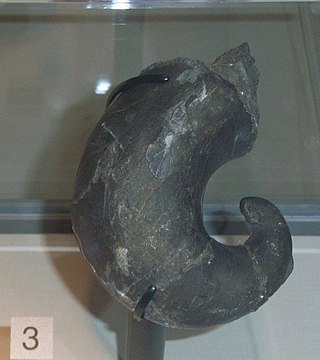Related Research Articles
Asthenoceras is a genus of ammonoid from the Middle Jurassic with dwarfish, evolute, smooth, compressed, discoidal, strongly keeled shell. Asthenoceras belongs to the Sonniniidae and may be a subgenus of the Lower Jurassic Grammoceras.
Acanthonautilus is an extinct genus in the nautilid family Solenochildae (Aipocerataceae) from the Upper Mississippian of North America and equivalent strata in Europe, first described by Foord in 1896.

Cenoceras is an extinct genus within the cephalopod mollusc family Nautilidae, which in turn makes up part of the superfamily Nautilaceae. This genus has been described by Hyatt in 1884. The type species is Cenoceras intermedium, which was originally described by Sowerby 1816 as Nautilus intermedius.
Tetragonoceras is an extinct prehistoric nautiloid genus from the nautilid family Tetragonoceratidae that lived during the Middle Devonian, found in Canada.
Sholakoceras is an extinct genus of nautiloid cephalopods from the Lower Permian of southern Russia, included in the Tainoceratacean family Rhiphaeoceratidae,. The shell of Shalakoceras is evolute with a perforate umbilicus. Whorl sections are subquadrate with the ventral and lateral sides flattened and ventral and umbilical shoulders rounded. Lateral areas bear short, slightly oblique ribs. sutures form broad ventral saddles with a slight, shallow lobe, very shallow lateral lobes, and a deep funnel-shaped dorsal lobe.
Uranoceras is a barrandeocerid genus from the Middle Silurian belonging to the family Uranoceratidae, characterized by its loosely coiled, gyroconic shell of 1.5 to 2 subquadrate whorls.
Strophiceras is an extinct genus of cephalopods from the Order Nautilida, which includes, in a separate family, Nautilus and Allonautilus.
Homaloceras is an extinct nautiloid cephalopod from the Middle Devonian with a strongly curved shell, included in the nautilid family Centroceratidae.
Permoceras, the sole member of the family Permoceratidae, is a genus of coiled nautiloids with a smooth, compressed involute shell, whorls higher than wide, earlier whorls hidden from view. The venter is rounded as are the ventral and umbilical shoulders, the flanks flattened. The siphuncle is ventrally subcentral. The suture, which is most characteristic, has a deep, narrow pointed ventral lobe and large, asymmetrical pointed lobes on either side.
Endolobus is an extinct genus from the nautiloid order, Nautilida. Nautiloids are a subclass of shelled cephalopods that were once diverse and numerous but are now represented by only a handful of species, including Nautilus. Endolubus is included in the family Koninckioceratidae which is part of the superfamily Tainoceratoidea.
Permonautilus is an extinct genus of nautilids from the Upper Permian of Russia, named and described by Kruglov in 1933. Permonautilus is an involute, globular, spinose member of the Lirocertidae which are included in the Clydonautilaceae. Whorl sections are broad, with a rounded venter. The umbilicus in the middle of the shell is deep, from which spine-like processes extend laterally in the mature portion near the aperture. The siphuncle in Permonautilus is subcentral, the suture, slightly sinuous.
Tetrapleuroceras is an extinct prehistoric nautiloid from the Lower Permian of the Urals in Russia. Nautilids are a type of nautiloid, a subclass of shelled cephalopods that were once diverse and numerous but now only represented by Nautilus and Allonautilus
Valhallites is an extinct genus in the nautiloid order Nautilida which includes the living Nautilus found in the tropical western Pacific Ocean. Valhalites belongs to the Koninckioceratidae, a family in the Tainoceratoidea, a nautilid superfamily.
Tylonautilus is an extinct genus in the nautiloid order Nautilida from the Lower Carboniferous of Europe and Permian of Japan.
Stearoceras is an extinct genus of prehistoric nautiloids from the Lower Pennsylvanian - Lower Permian with a fair worldwide distribution.(Kümmel 1964)
Trigonoceras is an extinct genus of prehistoric nautiloids from the nautilid family Trigonoceratidae that lived during the Early Carboniferous in what is now western Europe.
The Centroceratidae is the ancestral family of the Trigonoceratoidea and of the equivalent Centroceratina; extinct shelled cephalopods belonging to the order Nautilida

The Aipoceratoidea are a superfamily within the order Nautilida characterized by rapidly expanding, smooth to ribbed, cyrtoconic to coiled shells with rounded or sometimes dorsally flattened or impressed whorls, nearly straight sutures, and a ventral and marginal siphuncle. Septal necks are orthochoanitic ventrally and orthochoanitic or cyrtochoanitic dorsally.

The Nephriticeratidae is a family of early Paleozoic nautilod cephalopods included in the Barrandeocerina, distinguished by mostly cyrtoconic as well as gyroconic, sepenticontic, and sinstrally torticonic shells with large, typically straight necked (orthchoanitic) siphuncles. As for the suborder, connecting rings are thin.

Lobolytoceras is an extinct genus of ammonite in which only the inner whorls have large swollen ribs, later whorls have wrinkled growth lines which coarsen somewhat, near the aperture. The genus is known from the Lower Jurassic Toarcian of Europe. The type species L. siemensi (Denck) came from the Upper Toarcian of Germany.
References
- ↑ Paleobiology Database Nautiloceras entry
- 1 2 Kummel (1964). R.C. Moore (ed.). Part K, Mollusca 3. Treatise on Invertebrate Paleontology. Lawrence, Kansas: Geological Society of America and University of Kansas Press. p. K190–K216.
- ↑ Sepkoski, J.J. Jr. 2002. A compendium of fossil marine animal genera. D.J. Jablonski & M.L. Foote (eds.). Bulletins of American Paleontology363: 1–560. Sepkoski's Online Genus Database (CEPHALOPODA)